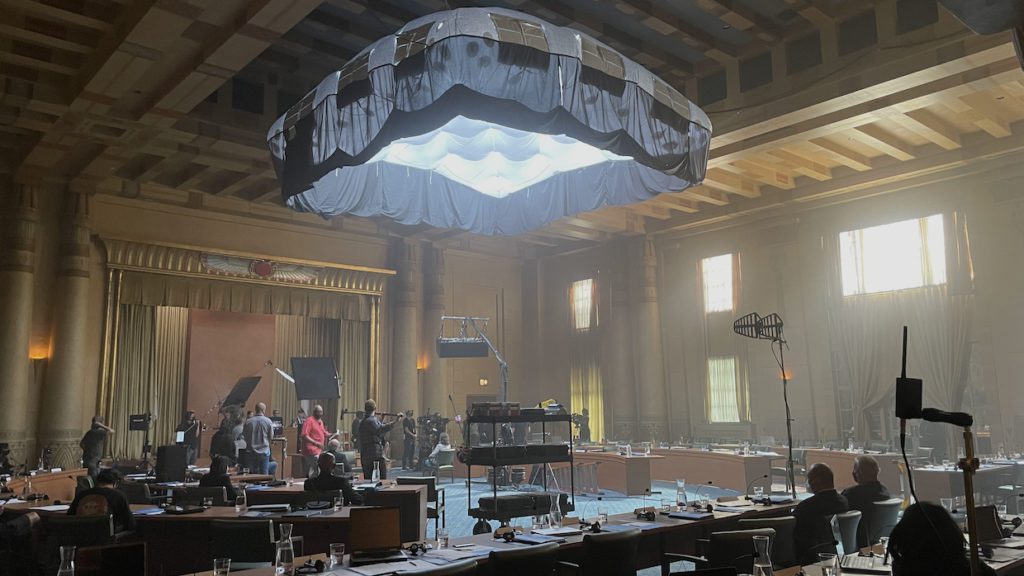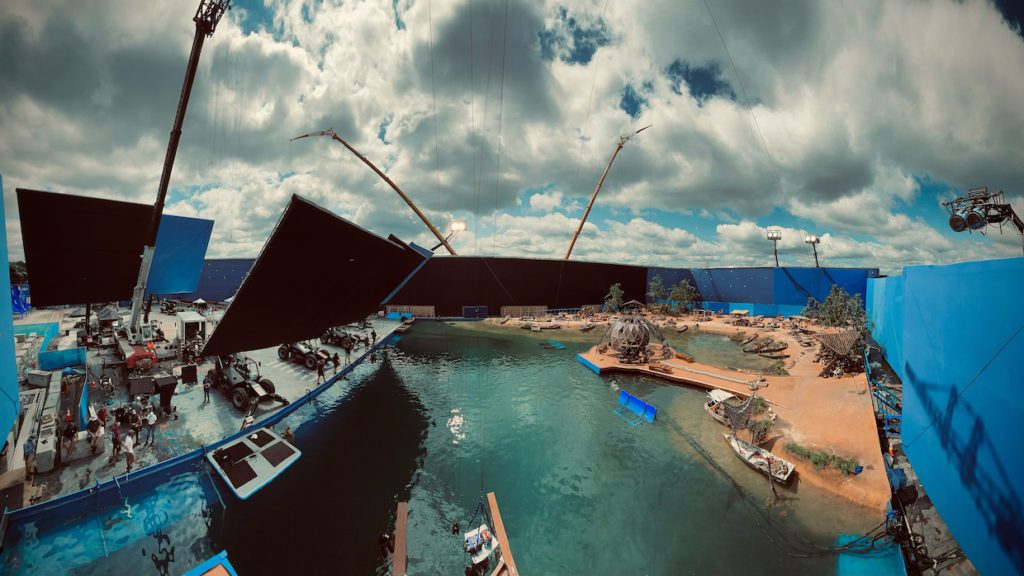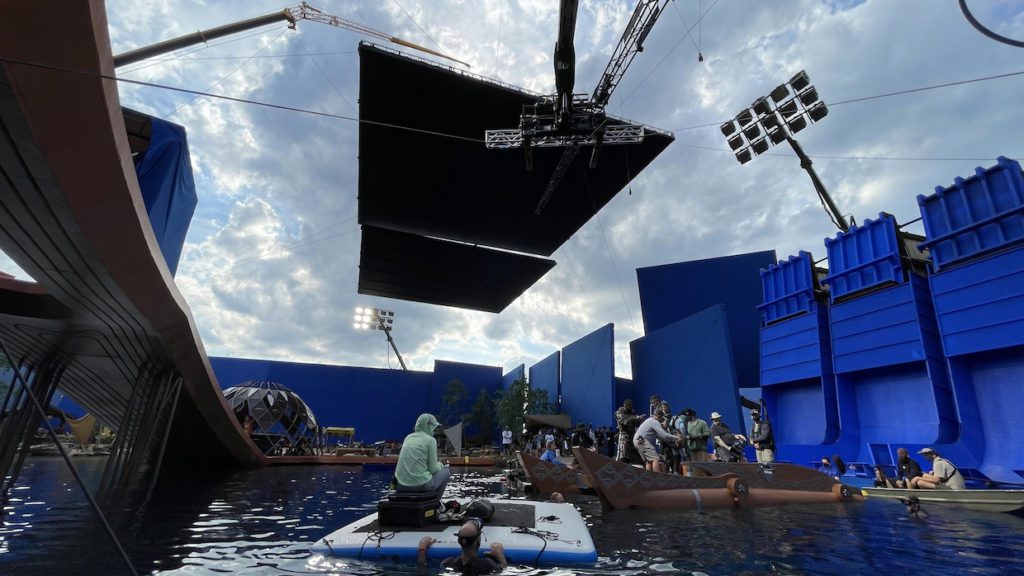 Back to selection
Back to selection
Shutter Angles
Conversations with DPs, directors and below-the-line crew by Matt Mulcahey
“Anamorphic’s Biggest Fan”: DP Autumn Durald Arkapaw on Black Panther: Wakanda Forever
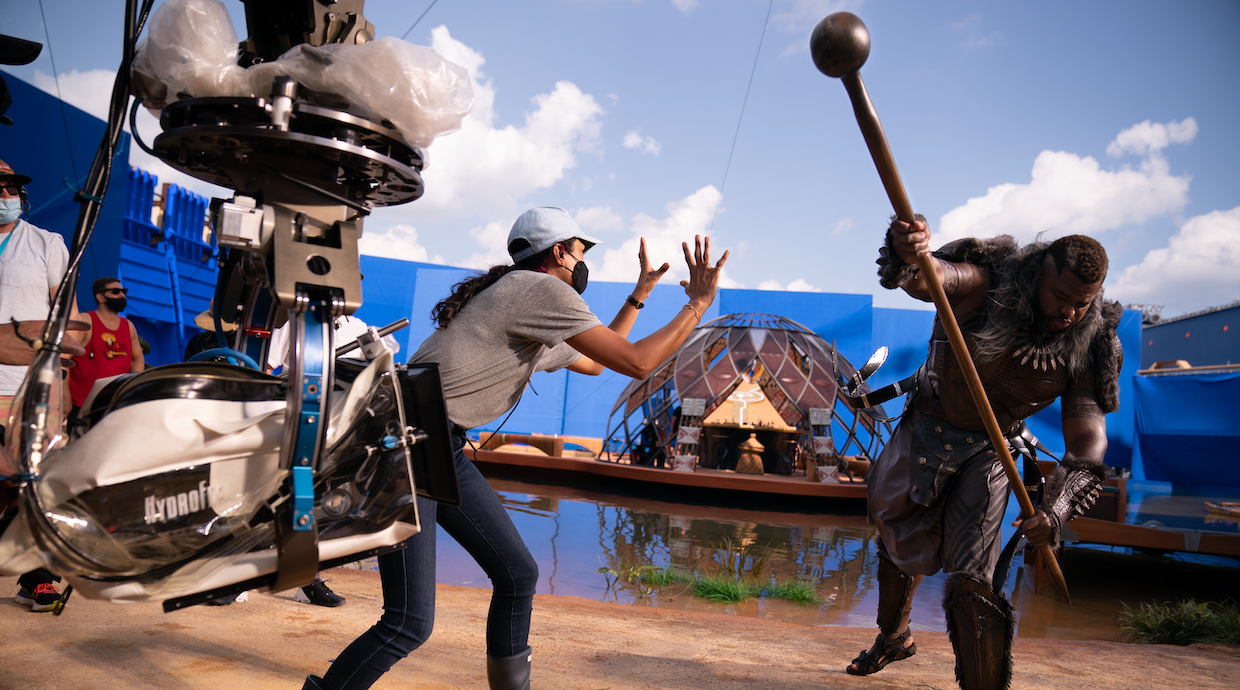 Autumn Durald Arkapaw and Winston Duke on the set of Black Panther: Wakanda Forever (Photo by Eli Adé)
Autumn Durald Arkapaw and Winston Duke on the set of Black Panther: Wakanda Forever (Photo by Eli Adé) Upon release in 2018, the first Black Panther became the highest grossing standalone super hero movie in history, while achieving a lasting cultural relevance exceedingly rare even among the box office juggernauts of the Marvel Cinematic Universe. But with the passing of Chadwick Boseman, the actor behind the titular hero, maintaining the status quo in the sequel was an impossibility. For Black Panther: Wakanda Forever, the story’s throughline became grief and the narrative center shifted from Boseman’s T’Challa to his sister Shuri (Letitia Wright) and mother Queen Ramonda (Angela Bassett, who received an Oscar nomination for the part).
That new focus required new tools, with cinematographer Autumn Durald Arkapaw transitioning the series to anamorphic lenses and large format cameras. With the movie now out on all formats—including physical media and streaming on Disney+—Durald Arkapaw spoke to Filmmaker about the influence of Alien, selecting the right sequences for IMAX and why she’s “anamorphic’s biggest fan.”
Filmmaker: The first Black Panther was shot on a Super35-sized Alexa sensor and with spherical lenses. I re-read DP Rachel Morrison’s interview with American Cinematographer for the first film and she said both of those decisions were influenced by director Ryan Coogler. He didn’t want the shallower depth of field of a large format sensor, and he was more familiar with spherical glass. What were the discussions with Ryan around moving to large format and anamorphic for Wakanda Forever?
Durald Arkapaw: I feel like the lens choice is actually the first thing the audience responds to. Everything is going through that lens. So, it’s a big deal to change the lenses and the format. When we first spoke about anamorphic, Ryan was really open to it. The majority of what I shoot is in the anamorphic format. Ryan always makes fun of me because I’m anamorphic’s biggest fan. [laughs] So, it was an easy conversation for me as far as trying to sell him on anamorphic and how the attributes he was looking for to help him tell this story were also the attributes I embrace whenever I shoot anamorphic. For instance, we had long conversations about the movie’s throughline of grief and how grief can present a fog over you. I told him that I thought the right lenses could really accentuate those emotional characteristics.
Filmmaker: What anamorphic lenses did you choose?
Durald Arkapaw: We used Panavision T Series anamorphics that we modified with Dan Sasaki at Panavision. I tend to embrace aberrations, fall off, field curvature and a particular type of flare that I love with certain focal lengths. All of those choices give the image a texture, but also an emotional quality that helped Ryan tell the story he was after. We’re introducing a new world, Talokan, and Ryan was interested in having the feeling of a deep space movie under the sea. Alien was one of the movies I responded to when I talked to him about creating tension and darkness. That film was shot on Panavision C Series lenses, so when we detuned our T Series I was after a lot of the characteristics you can get from the C Series. When we were modifying and testing lenses for this project, I also put a B Series lens in there as well. That was the lens Ryan responded to most—we shot maybe half the movie with that. It’s what we used for our pivotal closeups, and it was pretty much the main lens we told our story with. I found that lens when I was shooting Loki and fell in love with it. It was a 35mm and I tend to refer to the lenses by their focal length [before they’ve been expanded to fit large format cameras].
Filmmaker: Those original B Series are over 60 years old at this point. Do they have certain particularities you have to deal with when you use them?
Durald Arkapaw: When you shoot with lenses that have so much personality, they don’t all tend to be consistent if it’s not a newer modern series, so you just learn how to shoot them. You learn what stop to shoot a lens at to get varied effects with fall off or with the way light behaves at certain stops. I tend to shoot at around a 2.8, which is what we shot most of [Wakanda Forever] at. Coming up always shooting anamorphic, Panavision has been there my whole career. At times I’d be doing movies with no budget, and they would just give me whatever anamorphics they could find that were available. So, I’ve shot every single thing, and I keep the SKU numbers.
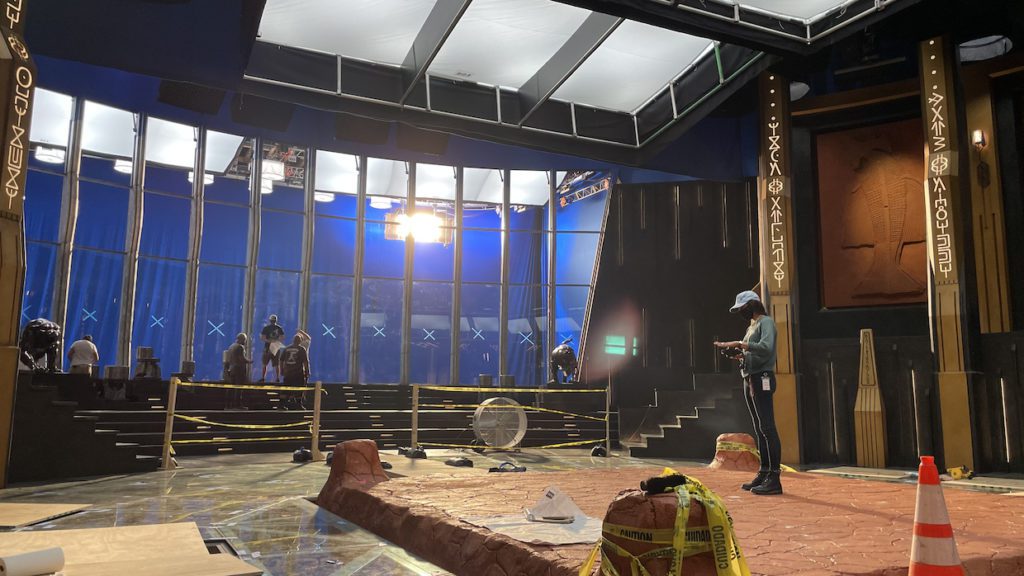
Filmmaker: When we talked for Loki, you said your references for Dan Sasaki for the detuning were The Yards and Blade Runner. What did you tell him for Wakanda Forever?
Durald Arkapaw: For this, I brought up Alien and The Abyss and some movies shot on film in the 1990s. But I think more than just giving a movie reference to Dan, it’s talking about what attributes I’m after. Where do we want the fall off? What type of aberrations? How much do they bend in the corners? What color are the flares?
Filmmaker: You shot on the Sony VENICE and you’re dealing with an IMAX aspect ratio for some scenes. What sensor mode did you shoot in to get that 1.9:1 IMAX frame?
Durald Arkapaw: We shot 6K in the 3:2 full frame mode with 1.3x anamorphics, which gave me a 1.9:1 deliverable. With the 1.3x anamorphics, I’m shooting most of the sensor and still getting some of the characteristics that you appreciate so much from 2x anamorphic, so that was a happy medium to arrive at.
Filmmaker: What is the process for deciding what is an IMAX sequence and what isn’t? Does an edict come down that says, “We want 25 percent of the movie in IMAX to entice people into seeing the film on IMAX screens?” Or does it come from your end, where you are suggesting which scenes you think lend themselves to the format?
Durald Arkapaw: Honestly, in my experience, from Loki to Panther, it’s so collaborative. Between the director and I and the producers, we’re having conversations about what’s going to tell the story the best, and that conversation is never pushed in one direction to accommodate some other deliverable. But we did struggle with that decision. When you’re shooting 2x anamorphic [for a 2.39 aspect ratio] and then go to IMAX, that’s a big change, right? It’s not like when you’re shooting spherical, where you can just crop it for 2.39, then extend the same frame for your IMAX height. With 2x anamorphic, you have to make the decision beforehand because once you shoot it, that’s what the frame is and it’s not going to go IMAX. I did a lot of testing, so I was able to show Ryan different options for how we would arrive at the IMAX. We even tested the Alexa 65 as an option just to be able to figure out what was the right fit in general. In the end, we did our bigger boat action sequences IMAX and added a little bit of underwater action in IMAX for shots that were mostly CG, so we could extend [the aspect ratio to an IMAX frame] later in post.
Filmmaker: There are wide shots in Wakanda Forever where you see anamorphic characteristics like barrel distortion in parts of the frame that are digital set extensions. How do you collaborate with the VFX team so they can add the unique personality of your lenses to their work?
Durald Arkapaw: I had such an amazing experience and relationship with my VFX team. My VFX supervisor, Geoff Baumann, and I instantly became best friends. He reached out early on when I came aboard, and we had a call just to get to know each other. We were already very like-minded individuals, and our tastes were in the same realm. Some people speak of that relationship [between the cinematographer and the VFX team] like it’s a push and pull, but we started with the same goal of making the photography and the VFX feel like one. We wanted everything to feel like the same world. When you have so much VFX, you want to try and do as much as you can in camera so you’re giving them something to ground the VFX in, but also [the post team] has to make sure that they’re doing as much work on set as they can, mapping and charting and learning the lenses so that they can give that information to their vendors so that our looks are consistent in principal and post. Our lenses on this could scare a VFX team away, but instead of looking at it negatively, we just looked at it as a challenge. They took the time to do more charts and mapping and flare tests. They also made a large document that they shared with the vendors that talked about my style of lighting—because they’re doing some CG lighting—and the particularities of this format that we were shooting with. That’s so important, and it’s so thoughtful to take the time to do that so that when their teams are incorporating light or figuring out where the sun is or how to light a face, that information is there for them and they’re not guessing.
Filmmaker: Have Marvel films gotten into using virtual cameras in VR environments for previs yet?
Durald Arkapaw: One day we had some sort of VR set-up, which is probably what you’re taking about, but I put it on and almost threw up. [laughs] It’s not really my cup of tea, so it wasn’t something I took advantage of. What I did take advantage of was working in Unreal Engine with Scott Meadows, our pre/post vis supervisor. I could pick cameras and pick where light sources came from. It was great, because Ryan brought me on early in non-consecutive prep to be a part of his previs and boarding prior to me being on the ground in Atlanta, and that’s so huge. A lot of these sequences are beasts and Ryan is starting to look at those and map them out really early on, maybe even a year before they’re shot. So, it was a big deal to be able to be involved in that process.
Filmmaker: Tom Poole from Company3 created your show LUT for Loki and did the final grade on Wakanda Forever. Tell me about that collaboration.
Durald Arkapaw: I enjoy working with Tom because we have the same taste. For example, we both like our blacks to sit in a certain spot, as far as how we like our shadows and the density of those blacks. I like to set as much of the look as I can on set, so when I pick a LUT or create a new LUT with Tom, I want it to do all the heavy lifting. I want the director to see as close to the [final image] on set as he or she can. Obviously, we’re doing a lot of bigger bluescreen sets on this one, so sometimes we’re just talking about skin tones and costumes at that point, but it’s still important. Tom made the LUT for Loki, but he was unable to do the final grade because we did it in-house. This time around, Tom was able to do the final grade and made a really beautiful new show LUT in preproduction, which we talked about with our post team and VFX as well. It had to be something that was friendly to everyone, but also gave the movie a very nice filmic quality.
Filmmaker: I was looking back at my notes from my Wakanda Forever screening and for the sequence where Namor is introduced in a night exterior by a riverbank, I scribbled down, “This is the darkest scene I’ve ever seen in a Marvel movie.”
Durald Arkapaw: The darkness was Ryan’s directive and I thought it was a very brave decision. That scene in general, even prior to Namor showing up [when Shuri and Ramonda are alone talking by firelight], was very important to Ryan. We talked about how if that scene was successful, the audience will buy into the movie as far as the heart of our story and what we were trying to say. So, it was very important that scene work on the page and also photographically. When we first discussed the scene in prep, we decided to shoot it at a real location with a manmade lake on a huge farm out in Atlanta, where they had shot some big exterior sequences on the first movie. It was going to be a huge set up. I’d have to light acres of night and trees. I’d also have to get equipment in there and it was going to be muddy. We’d be putting [Namor actor Tenoch Huerta] in a real lake, and he’d need [to fly out of the water], so there’s rigging involved. We went out there many times to talk about prepping that and what equipment would be used. Then we had some schedule changes and decided to shoot that scene on stage instead. because we had to shoot it in the winter now and it would be too cold outside. So, we put it on a stage and [production designer] Hannah Beachler was able to build a great set.
It’s very difficult to do night work that’s supposed to be on a stage when all of your sources are coming from the moon or fire. A lot of times when you see those scenes in movies it looks fake, and it’s overlit. So, the darkness in that scene comes from wanting it to feel real, but also Ryan really wanted there to be this tension when Namor comes out of the river where the audience wonders what [is emerging from the water]. I think it’s a misconception in filmmaking that we feel like we have to see everything, that it has to be bright so that we can understand what’s going on. Sometimes things can be dark and can give you an understanding as well. In this case, we’re trying to create this tension of these women not understanding what they’re seeing and staring out into this abyss of black, then all of sudden he arrives. It’s the first representation of Namor, so it’s a big deal.
Filmmaker: Let’s finish up by talking about shooting underwater. How much of the water work is wet for wet and how much is dry for wet?
Durald Arkapaw: The most successful underwater shots that I’ve seen in films are actually shot underwater. So, you’re always trying to reach that target. Does this look like it’s really underwater? We had a 20-foot tank that we built on a stage, and most actors took swimming lessons and spent weeks learning to swim better so they would feel more comfortable in our tank. We did wet for wet with our real actors in the water as much as we could so that our VFX vendor Wētā had a reference for that look and movement. Then we shot it again dry for wet, so that Wētā could take those two plates and put them together and ultimately we would have a believable shot based off of both those environments. So, for instance, when Namor descends into his throne, we shot that both ways—wet for wet and dry for wet so they would have a reference for turbidity, color absorption, magnification changes and desired contrast ratios. We would use the same exact lighting for wet for wet and dry for wet so they would have lighting references that matched. I think all three types of this photography—the CG, the dry for wet and the wet for wet—live in the edit, back-to-back. So, it’s really great to see that all of that work that went into putting as much as we could underwater— costumes, sets, people—was very valuable.
Filmmaker: When you did the dry for wet shots, did you shoot off-speed to make the movement feel more like it would underwater?
Durald Arkapaw: Yeah, we shot that at 48 frames. That was another advantage of also shooting the scenes wet for wet. When you put actors in the water and they get a sense of how their body moves, it informs the performance when you shoot the scenes again dry for wet.
